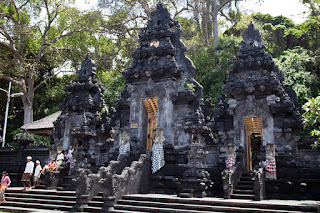Prambanan is the ninth century Hindu temple compound in Central Java, Indonesia, dedicated to Trimurti, the expression of God as the Creator (Brahma), the Sustainer (Vishnu) and the Destroyer (Shiva). The temple compound located approximately 18 km east of Yogyakarta city on the boundary between Yogyakarta and Central Java province.
The temple is a UNESCO World Heritage Site, currently is the largest Hindu temple in Indonesia, and is one of the largest Hindu temples in south-east Asia. It is characterised by its tall and pointed architecture, typical of Hindu temple architecture, and by the towering 47m high central building inside a large complex of individual temples.
Prambanan is the largest Hindu temple of ancient Java, and the construction of this royal temple was probably started by Rakai Pikatan as the Hindu Sanjayas answer to the Buddhist Sailendra's Borobudur and Sewu temples nearby. Historians suggested that the construction of Prambanan probably was meant to mark the return of Hindu Sanjaya dynasty to power after almost a century fell under Buddhist Sailendra domination on Central Java. Nevertheless the construction of this massive Hindu temple signify that the Medang court has shifted its patronage from previously favour Mahayana Buddhism to Shivaist Hinduism.
A temple was first built at the site around 850 CE by either Rakai Pikatan or Balitung Maha Sambu the Sanjaya king of the Mataram Kingdom. According to Shivagrha inscription that wrote chandrasengkala ”Wwalung gunung sang wiku” (778 Saka/856 M), the temple was built to honor lord Shiva and the original name of the temple is Shiva-grha (the house of Shiva). Indeed, some archaeologists propose that the idol of Shiva in the garbhagriha (central chamber) of the main temple is modelled after King Balitung, serving as a depiction of his deified self after death.
 The temple compound was expanded by successive Mataram kings such as Daksa and Tulodong with the addition hundreds of perwara temples around the chief temple. Prambanan served as the royal temple of the Hindu Kingdom of Mataram, with most of the state's religious ceremonies and sacrifices being conducted there. At the height of the Mataram kingdom, scholars estimate that hundreds of Brahmins with their disciples lived within the outer wall of the temple compound. The urban center and the court of Mataram were located nearby, somewhere in the Prambanan Plain.
The temple compound was expanded by successive Mataram kings such as Daksa and Tulodong with the addition hundreds of perwara temples around the chief temple. Prambanan served as the royal temple of the Hindu Kingdom of Mataram, with most of the state's religious ceremonies and sacrifices being conducted there. At the height of the Mataram kingdom, scholars estimate that hundreds of Brahmins with their disciples lived within the outer wall of the temple compound. The urban center and the court of Mataram were located nearby, somewhere in the Prambanan Plain.The Prambanan compound also known as Loro Jonggrang complex, named after the popular legend of Loro Jonggrang. There are 237 temples in this Shivaite temple complex, either big or small. But the majority of them have deteriorated, what is left are only scattered stones. The Prambanan temple complex consists of three zones; first the outer zone, second the middle zone that contains hundreds of small temples, and third the holiest inner zone that contains eight main temples and eight small shrines.
The outer zone is a large space marked by a rectangular wall (destroyed). The original function is unknown; possibilities are that it was a sacred park, or priests' boarding school (ashram). The supporting buildings for the temple complex were made from organic material; as a consequence no remains occur.
The middle zone consists of four rows of 224 individual small shrines. There are great numbers of these temples, but most of them are still in ruins and only some have been reconstructed. These concentric rows of temples were made in identical design. Each row towards the center is slightly elevated. These shrines are called "Candi Perwara" guardian or complementary temples, the additional buildings of the main temple. Some believed it was offered to the king as a sign of submission. The Perwara are arranged in four rows around the central temples, some believed it has something to do with four castes, made according to the rank of the people allowed to enter them; the row nearest to the central compound was accessible to the priests only, the other three were reserved for the nobles, the knights, and the simple people respectively. While another believed that the four rows of Perwara has nothing to do with four castes, it just simply made as meditation place for priests and as worship place for devotees.
The inner zone or central compound is the holiest among the three zones. It’s the square elevated platform surrounded by square stone wall with stone gates on each four cardinal points. This holiest compound is assembled of eight main shrines or candi. The three main shrines, called Trimurti ("three forms"), are dedicated to the three gods: Brahma the Creator, Vishnu the Keeper, and Shiva the Destroyer.
The Shiva temple is the tallest and largest structure in Prambanan Loro Jonggrang complex, it measures 47 metres tall and 34 metres wide. The Shiva temple encircled with galleries adorned with bas-reliefs telling the story of Ramayana carved on the inner walls of the balustrades. To follow the story accordingly, visitors must enter from the east side and began to perform pradakshina or circumambulating clockwise. The bas-reliefs of Ramayana continued to Brahma temple galleries.
 The Shiva shrine located at the center and contains five chambers, four small chambers in every cardinal direction and one bigger main chamber in central part of the temple. The east chamber connect to central chamber that houses the largest temple in Prambanan, a three meter high statue of Shiva Mahadeva (the Supreme God). The statue bears Lakcana (attributes or symbol) of Shiva such as skull and sickle (crescent) at the crown, and third eye on the forehead, also four hands that holds Shiva's symbols: a prayer beads, feather duster, and trisula (trident). Some historians believe that the depiction of Shiva as Mahadeva also meant to personify king Balitung as the reincarnation of Shiva. So, when he died, a temple was built to commemorate him as Shiva. The statue of Shiva stands on lotus pad on Yoni pedestal that bears the carving of Naga serpents on north side of pedestal.
The Shiva shrine located at the center and contains five chambers, four small chambers in every cardinal direction and one bigger main chamber in central part of the temple. The east chamber connect to central chamber that houses the largest temple in Prambanan, a three meter high statue of Shiva Mahadeva (the Supreme God). The statue bears Lakcana (attributes or symbol) of Shiva such as skull and sickle (crescent) at the crown, and third eye on the forehead, also four hands that holds Shiva's symbols: a prayer beads, feather duster, and trisula (trident). Some historians believe that the depiction of Shiva as Mahadeva also meant to personify king Balitung as the reincarnation of Shiva. So, when he died, a temple was built to commemorate him as Shiva. The statue of Shiva stands on lotus pad on Yoni pedestal that bears the carving of Naga serpents on north side of pedestal.The other three smaller chambers contain statues of Hindu Gods related to Shiva; his consort Durga, the rishi Agastya, and Ganesha, his son. Statue of Agastya occupy the south chamber, the west chamber houses the statue of Ganesha, while the north chamber contains the statue of Durga Mahisasuramardini depicting Durga as the slayer of Bull demon. The shrine of Durga is also called the temple of Lara Jonggrang (Javanese: slender virgin), after a Javanese legend of princess Lara Jonggrang.
The two other main shrines are that of Vishnu on the north side of Shiva shrine, and the one of Brahma on the south. Both temple facing east and each contain only one large chamber, each dedicated to respected gods; Brahma temple contains the statue of Brahma and Vishnu temple houses the statue of Vishnu. Brahma and Vishnu temple measures 20 metres wide and 33 metres tall.
The bas-reliefs along the balustrades on the gallery around Shiva and Brahma temple depict the Ramayana legend. They illustrate how Sita, the wife of Rama, is abducted by Ravana. The monkey king Hanuman brings his army to help Rama and rescue Sita. This story is also shown by the Ramayana Ballet, regularly performed at full moon at Trimurti open air theatre in west side of the illuminated Prambanan complex. On the balsutrades in Vishnu temple there is series of bas-relief depict Krishnayana, the story of lord Krishna.
Between these row of main temple, on north and south side stands two Candi Apit. Beside these 8 main temples, there's also 8 smaller shrines; 4 Candi Kelir on four cardinal direction of the entrance, and 4 Candi Patok on four corner.
 The other three shrine in front of three main temples is dedicated to vehicle (vahana) of the respective gods - the bull Nandi for Shiva, the sacred swan Hamsa for Brahma, and Vishnu's Eagle Garuda. Precisely in front of Shiva temple stands Nandi temple which contains a statue of Nandi bull, the vehicle (vahana) of Lord Shiva. Besides it, there is also other statues, the statue of Chandra the god of moon and Surya the god of sun. Chandra stands on his carriage pulled by 10 horses, and the statue of Surya also standing on a carriage pulled by 7 horses. Facing Brahma temple is the temple of Hamsa or Angsa (sacred swan). In the chamber of this temple contains no statue. But it seems likely that there was once a statue of the sacred swan, vehicle of god Brahma. In front of Vishnu temple is the temple dedicated for Garuda, however just like the Hamsa temple, Garuda temple contains no statue. Probably this temple once contains the statue of Garuda, the vehicle of Vishnu. Garuda holds important role for Indonesia, which serves as the national symbol of Indonesia, also to the airline Garuda Indonesia.
The other three shrine in front of three main temples is dedicated to vehicle (vahana) of the respective gods - the bull Nandi for Shiva, the sacred swan Hamsa for Brahma, and Vishnu's Eagle Garuda. Precisely in front of Shiva temple stands Nandi temple which contains a statue of Nandi bull, the vehicle (vahana) of Lord Shiva. Besides it, there is also other statues, the statue of Chandra the god of moon and Surya the god of sun. Chandra stands on his carriage pulled by 10 horses, and the statue of Surya also standing on a carriage pulled by 7 horses. Facing Brahma temple is the temple of Hamsa or Angsa (sacred swan). In the chamber of this temple contains no statue. But it seems likely that there was once a statue of the sacred swan, vehicle of god Brahma. In front of Vishnu temple is the temple dedicated for Garuda, however just like the Hamsa temple, Garuda temple contains no statue. Probably this temple once contains the statue of Garuda, the vehicle of Vishnu. Garuda holds important role for Indonesia, which serves as the national symbol of Indonesia, also to the airline Garuda Indonesia.
 The other three shrine in front of three main temples is dedicated to vehicle (vahana) of the respective gods - the bull Nandi for Shiva, the sacred swan Hamsa for Brahma, and Vishnu's Eagle Garuda. Precisely in front of Shiva temple stands Nandi temple which contains a statue of Nandi bull, the vehicle (vahana) of Lord Shiva. Besides it, there is also other statues, the statue of Chandra the god of moon and Surya the god of sun. Chandra stands on his carriage pulled by 10 horses, and the statue of Surya also standing on a carriage pulled by 7 horses. Facing Brahma temple is the temple of Hamsa or Angsa (sacred swan). In the chamber of this temple contains no statue. But it seems likely that there was once a statue of the sacred swan, vehicle of god Brahma. In front of Vishnu temple is the temple dedicated for Garuda, however just like the Hamsa temple, Garuda temple contains no statue. Probably this temple once contains the statue of Garuda, the vehicle of Vishnu. Garuda holds important role for Indonesia, which serves as the national symbol of Indonesia, also to the airline Garuda Indonesia.
The other three shrine in front of three main temples is dedicated to vehicle (vahana) of the respective gods - the bull Nandi for Shiva, the sacred swan Hamsa for Brahma, and Vishnu's Eagle Garuda. Precisely in front of Shiva temple stands Nandi temple which contains a statue of Nandi bull, the vehicle (vahana) of Lord Shiva. Besides it, there is also other statues, the statue of Chandra the god of moon and Surya the god of sun. Chandra stands on his carriage pulled by 10 horses, and the statue of Surya also standing on a carriage pulled by 7 horses. Facing Brahma temple is the temple of Hamsa or Angsa (sacred swan). In the chamber of this temple contains no statue. But it seems likely that there was once a statue of the sacred swan, vehicle of god Brahma. In front of Vishnu temple is the temple dedicated for Garuda, however just like the Hamsa temple, Garuda temple contains no statue. Probably this temple once contains the statue of Garuda, the vehicle of Vishnu. Garuda holds important role for Indonesia, which serves as the national symbol of Indonesia, also to the airline Garuda Indonesia.Architecture
The architecture of Prambanan temple follows the typical Hindu architecture traditions based on Vastu Shastra. The temple design incorporated mandala temple plan arrangements and also the typical high towering spires of Hindu temples. Prambanan was originally named Shivagrha and dedicated to god Shiva. The temple was designed to mimic Meru, the holy mountain the abode of Hindu gods, and the home of Shiva. The whole temple complex is a model of Hindu universe according to Hindu cosmology and the layers of Loka.
Just like Borobudur, Prambanan also recognize the hierarchy of the temple zones, spanned from the less holy to the holiest realms. Each Hindu and Buddhist concepts has their own terms, but the concept's essentials is identical. Either the compound site plan (horizontally) or the temple structure (vertically) are consists of three zones:
- Bhurloka (in Buddhism: Kamadhatu), the lowest realm of common mortals; humans, animals also demons. Where humans still binded by their lust, desire and unholly way of life. The outer courtyard and the foot (base) part of each temples is symbolized the realm of bhurloka.
Bhuvarloka (in Buddhism: Rupadhatu), the middle realm of holy people, rishis, ascetics, and lesser gods. People here began to see the light of truth. The middle courtyard and the body of each temples is symbolized the realm of bhuvarloka.
- Svarloka (in Buddhism: Arupadhatu), the highest and holiest realm of gods, also known as svargaloka. The inner cortyard and the roof of each temples is symbolized the realm of svarloka. The roof of the Prambanan temples is adorned and crowned with ratna (sanskirt: jewel). In ancient Java temple architecture, ratna is Hindu counterpart of Buddhist stupa, and served as the temple's pinnacle.
 During the restoration, a well which contains pripih (stone casket) was discovered under the center of the Shiva temple. The main temple has a well of 5.75 m depth in which a stone casket was found on top a pile of charcoal, earth and remains of burned animal bones. Sheets of gold leaves with the inscription Varuna (god of the sea) and Parvata (god of the mountains) were found here. The stone casket contained sheets of copper mixed with charcoal, ashes and earth, 20 coins, jewels, glass, pieces of gold and silver leaves, seashells and 12 gold leaves (5 of which in the shape of a turtle, Naga serpent, padma, altar and egg).
During the restoration, a well which contains pripih (stone casket) was discovered under the center of the Shiva temple. The main temple has a well of 5.75 m depth in which a stone casket was found on top a pile of charcoal, earth and remains of burned animal bones. Sheets of gold leaves with the inscription Varuna (god of the sea) and Parvata (god of the mountains) were found here. The stone casket contained sheets of copper mixed with charcoal, ashes and earth, 20 coins, jewels, glass, pieces of gold and silver leaves, seashells and 12 gold leaves (5 of which in the shape of a turtle, Naga serpent, padma, altar and egg).Source: http://en.wikipedia.org/wiki/Prambanan
Images: http://commons.wikimedia.org/wiki/Category:Prambanan
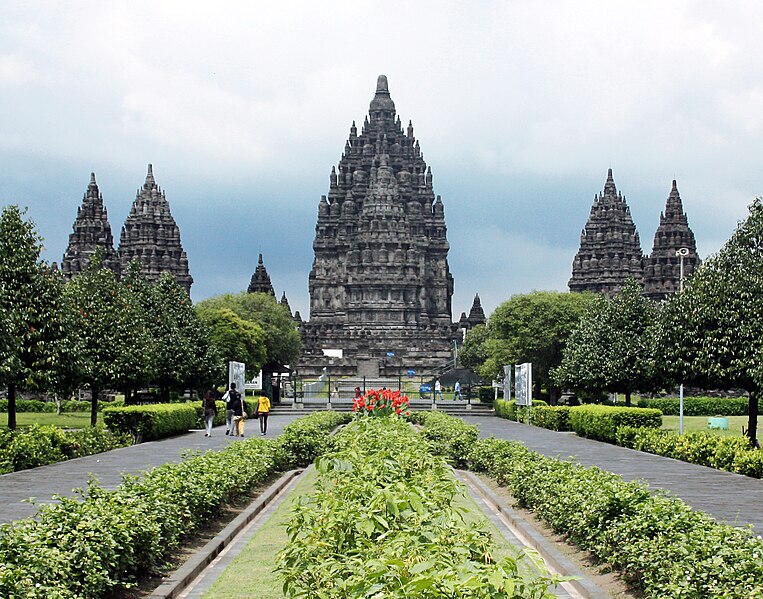

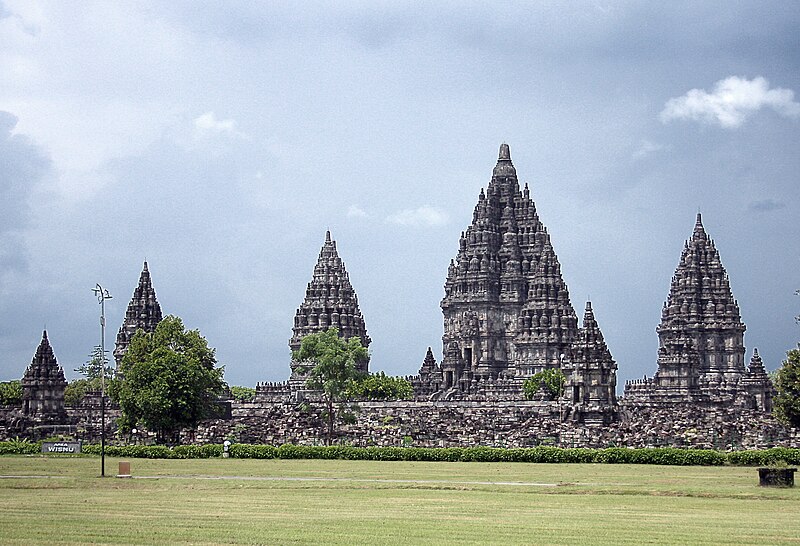




















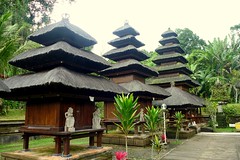

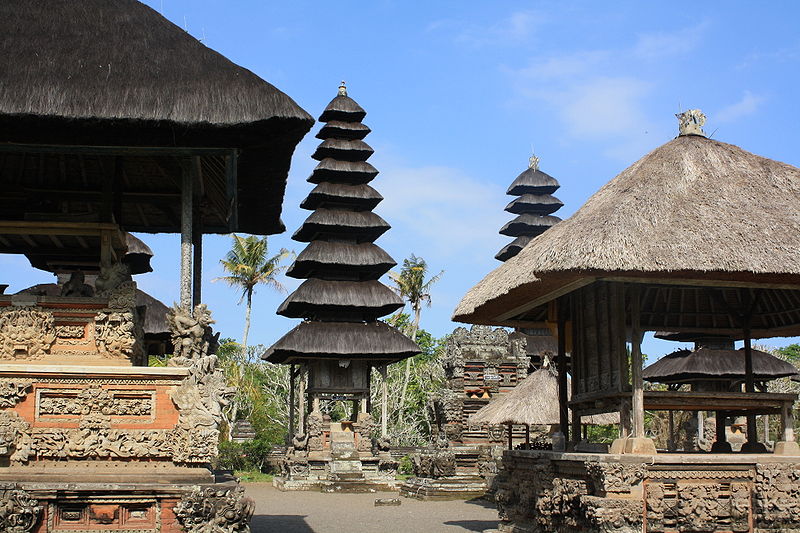
.jpg)




